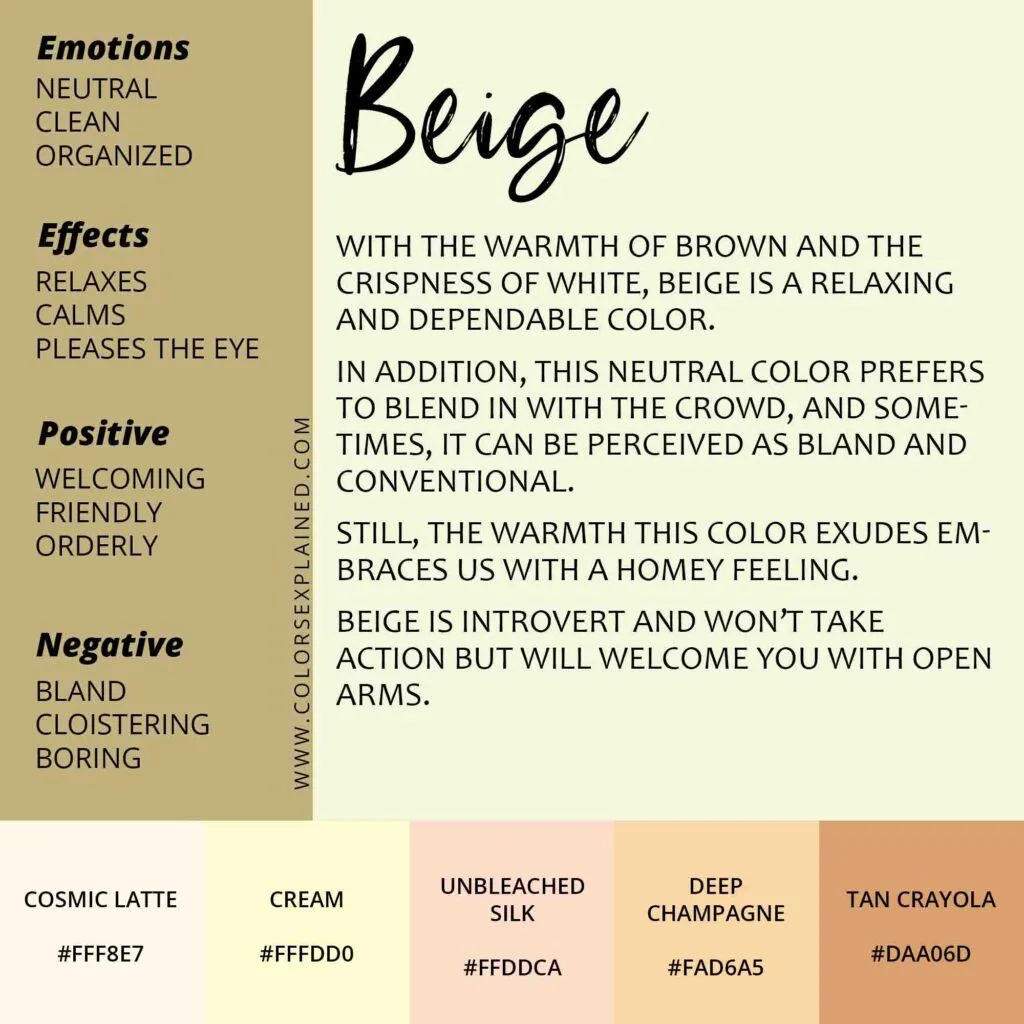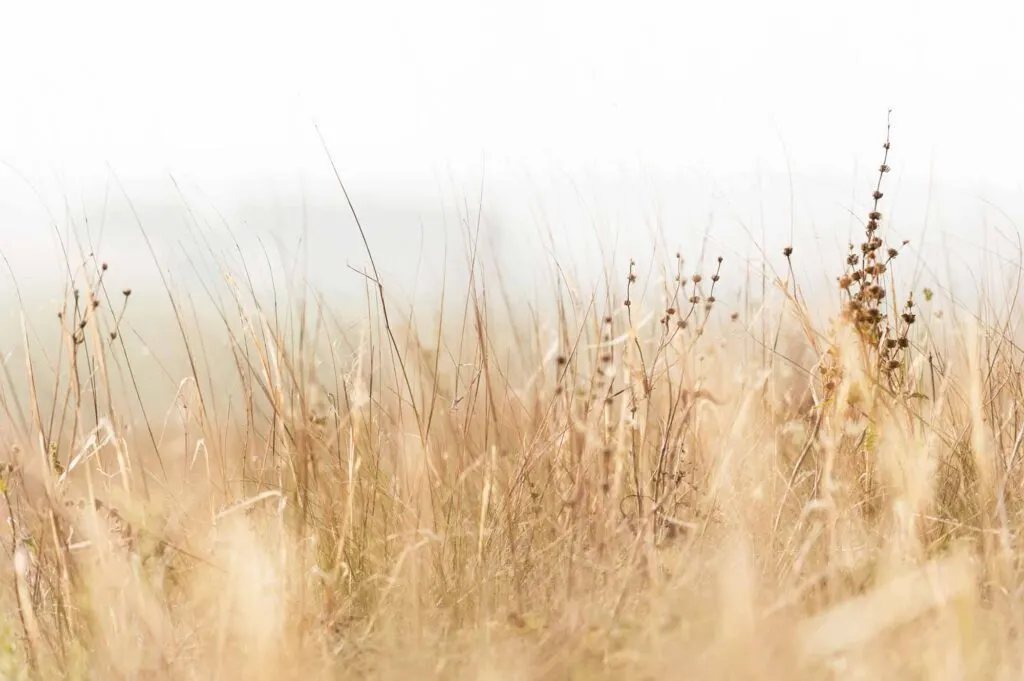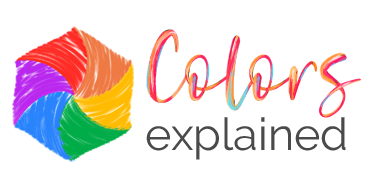Beige is the color of neutrality, cleanliness, and organization
As part of the Color Meaning Series, we’ll discuss the symbolism and meaning of the color beige.
For many more colors, check out our guide on color meanings.

Where can we find the meaning of the color beige?
Is it in the fabrics’ natural fibers or outdated electronics products? Maybe it is in the welcoming and relaxing interior decoration or soothing dry grass fields.
Beige is a relaxing color that is often used to complement a color palette due to its neutrality. The color beige is everywhere in our lives, and for good reason, as we will see in this article.
Today, we’ll talk about the symbolism and meaning of beige, its physical effects, most popular shades, common uses–all about the relaxing beige.
Beige Color Symbolism in Different Cultures
- Although it goes by many names and shades, the color beige’s meaning remains the same. It’s often referred to as French beige, Tuscan, cream, mode beige, desert sand, khaki, ecru, or unbleached silk. It’s essentially a blend of light gray, brown, and yellow, creating a pale yellow color that’s very easy on the eyes.
- The term “beige” originated in France around the middle of the 19th century, when it was used to describe the natural color of wool. This makes sense, given the meaning of the color beige is now synonymous with its homespun, comforting, slightly rustic nature.
- Beige remains a very popular color in home design and decoration to this day. It plays well with other colors and gives a lovely balance of neutrality, calm, and comfort.
- In the 1960s, the United States telephone company AT&T debuted a desert sand-colored telephone. They called the hue “beige.” This solidified beige’s meaning in the public mind as a very homey color.
- Makeup companies tend to use “beige” as a standard color for light to medium skin tones in their products.
- The first computers were beige, which has given the color an association with the working world.
Psychological Meaning of Beige

Beige Color Meaning
Here’s some insight into the meaning of beige, according to color psychology.
Conventional Thinking
The color beige is synonymous with the basics. It prioritizes a warm, relaxing environment and traditional values like the nuclear family, comfort, relaxation, and the home. Beige isn’t looking to stand out or break the mold.
Neutrality (and Perhaps Conformity)
Beige isn’t the color you want when you’re looking to stand out or go against the grain. That said, it’s a perfect color for when you want to blend in with the crowd. After all, beige is perhaps the most popular neutral color.
It’s very popular with those with a strong urge to be seen as normal. However, this aggressive sense of normalcy can be read as blandness to some.
Imagine a pair of beige work pants. What some people see as professional, buttoned-up, and a safe fashion choice, others might find cloistering and boring.
Cleanliness
Beige shows dirt and grime easily, so it often goes hand in hand with the need for a clean living area when used in homes. In extreme cases, this can turn obsessive but can remain in check as well.
This is a similar phenomenon to wearing white; any little blemish shows. But unlike white, beige is slightly warmer-feeling. Beige prioritizes comfort and practicality more than white does.
On top of that, beige is a great background color for designs where you want to stir away from white starkness.

Order, Organization, and Symmetry
Since beige goes with just about any color, it’s an extremely popular pick for people with a strong desire for color coordination. That’s why it’s the perfect paint color for rooms where you want to add some color, but without being too noticeable.
But unlike other neutrals like white and black, beige blends in rather than standing out starkly. It almost fades into the background – which can be a good or a bad thing.
The Natural World
Given the origins of its name, it’s no surprise that beige is often associated with the natural world. Those who love the color beige often seek naturalness and wholesomeness in other areas of their life, including eating natural and organic foods and limiting their use of artificial cosmetics and fragrances.
Many natural products use beige in their branding and packaging since it signifies a desire to go back to the basics and what’s familiar – the simple comforts that have existed long before our current, fast-paced digital age.
Friendly and Welcoming, but Not Exuberant
Beige is a beautiful color that communicates openness, but not necessarily extroversion.
If you’re at a party and you see someone wearing beige, you’ll probably get the impression that they’re a nice, normal, welcoming person who would be open to having a conversation with you – but who might not actively seek out that interaction.
With beige, what you see is what you get. Beige lovers can be easy to read and understand. To some, that may seem shallow. To others, it may be comforting.
This pale yellow-brown color is welcoming but it won’t take action.

Physical Effects of Beige
- Beige blends well with a variety of skin tones, which means it may feel like home to a lot of people. It’s a crowd-pleasing color that often appeals to people-pleasers.
- While beige is very calming, it can also be under-stimulating. It can bore some people and even make them antsy. This is because it lacks the “wow” factor of brighter, bolder colors.
Shades of Beige
Here are some of the most common beige shades with hex codes. If you’re going for an earthy palette, pick a few beiges for your design. It’s a warm color that’s never out of fashion.
Cream: #FFFDD0
Cosmic Latte: #FFF8E7
The shade of beige above is a creamy color often used in interior design. It’s also a popular and classic paint color.
Unbleached Silk: #FFDDCA
Deep Champagne: #FAD6A5
Tan Crayola: #DAA06D
Ecru: #C2B280
Khaki: #C3B091
Light French Beige: #C8AD7F
Desert Sand: #EDC9AF
Most Common Uses of the Color Beige
- Make-up
- Fabric/clothing
- Paint color
- Interior design
- Furniture
- Packaging
Beige means: neutral, clean, and organized
Effects of beige: relaxing, calming, and eye-pleasing
Positive traits: welcoming, friendly, and orderly
Negative traits: bland, cloistering, and boring
